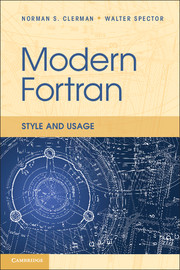Book contents
- Frontmatter
- Contents
- Source Code Listings
- Preface
- 1 Introduction
- 2 General Principles
- 3 Formatting Conventions
- 4 Naming Conventions
- 5 Documentation Conventions
- 6 Programming Principles
- 7 Programming Conventions
- 8 Input and Output
- 9 Packaging Conventions
- 10 Generic Programming
- 11 Object Orientation
- 12 Parallel Processing
- 13 Numerical Types, Kinds, and Operations
- 14 C Interoperability
- 15 Updating Old Programs
- A Source Code
- B Rule List
- Bibliography
- Index
12 - Parallel Processing
Published online by Cambridge University Press: 05 December 2011
- Frontmatter
- Contents
- Source Code Listings
- Preface
- 1 Introduction
- 2 General Principles
- 3 Formatting Conventions
- 4 Naming Conventions
- 5 Documentation Conventions
- 6 Programming Principles
- 7 Programming Conventions
- 8 Input and Output
- 9 Packaging Conventions
- 10 Generic Programming
- 11 Object Orientation
- 12 Parallel Processing
- 13 Numerical Types, Kinds, and Operations
- 14 C Interoperability
- 15 Updating Old Programs
- A Source Code
- B Rule List
- Bibliography
- Index
Summary
In the world of scientific and engineering computing, applications must often take advantage of all the processing power the system is capable of providing. With the advent of low-cost computers with multiple processing cores, writing programs that employ parallel processing has become common.
Modern computers operate in the digital domain, yet users wish to simulate or control physical processes, which are usually continuous, or analog, in nature. The conversion between the two domains is necessarily imprecise. The closer the digital process can model the real-world one, the better the result.
A numerical model must be fine-grained enough to accurately model the process, yet it must not be too fine, or resource requirements such as CPU utilization and main memory space will be exceeded. A practical choice must often be made between precision of results and the ability to produce results in a reasonable time frame, if at all.
When faced with the requirement to speed up a computation, it is natural to consider parallel processing as a solution. At its inception, Fortran was designed in terms of a scalar processor model. That is, only a single thread of control is present, and code is executed in a serial fashion. However, as computers have evolved, many features have been added to the language that can be executed in parallel. These parallel capabilities are built in. Their use depends on the hardware available and the compiler.
- Type
- Chapter
- Information
- Modern FortranStyle and Usage, pp. 216 - 246Publisher: Cambridge University PressPrint publication year: 2011

